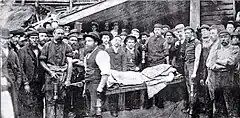Brunner Mine disaster
The Brunner Mine disaster happened at 9:30 am on Thursday 26 March 1896 (NZMT; UTC+11:30), when an explosion deep in the Brunner Mine, in the West Coast region of New Zealand, killed all 65 miners below ground. The Brunner Mine disaster is the deadliest mining disaster in New Zealand's history.[1]
 One of the deceased miners being recovered from the mine | |
| Date | 26 March 1896 |
|---|---|
| Time | 9:30 am (NZMT; UTC+11:30) |
| Location | Brunner Mine, West Coast, New Zealand |
| Deaths | 65 |
The royal commission of inquiry put the cause of the disaster to a blown-out shot in a part of the mine where miners should not have been working.[2] However, experienced miners claimed the explosion was caused by firedamp igniting, which had accumulated in the mine due to inadequate ventilation.[1][3]
Accident and response
It is most likely that the explosion was caused by firedamp, a common hazard in coal mines when a pocket of methane gas is accidentally ignited and explodes. Firedamp is all the more hazardous because of the after effects of the explosion. Gases known as "afterdamp" – carbon dioxide, carbon monoxide and nitrogen produced by the explosion – often prove to be just as deadly and can kill miners unhurt by the explosion itself.[4]
"Joseph Scott, the Blackball Mine Manager.., believed that the majority (of miners) were killed by the explosion and "not more than half a dozen by the afterdamp". Robert Russell, believing the explosion to be caused by firedamp, while acknowledging that the explosion force and coal dust flames contributed to the causes of death, believed that "at the end it was the afterdamp gases that killed them (all)." Dr. James McBrearty's description of many victims frothing at the mouth, suggests asphyxiation by the predominant afterdamp gas, being carbon dioxide. The afterdamp gas carbon monoxide which presented such a problem for the recovery teams must also have contributed to death through poisoning. It was not then fully appreciated that only small quantities of carbon monoxide or white damp could be fatal".[5]
Rescuers entering the mine after the explosion found themselves suffocating on the afterdamp gas and had to return to the surface, often unconscious, carried by other rescuers;[5] however, the determination was such to find the bodies, and to find any survivors, that the rescuers – mostly miners from nearby mines – would insist on returning to the airless mine as soon as they had been revived on the surface.[6] Miners came from as far as Denniston to assist the rescue effort, though it took the Denniston miners several days to arrive as they had to travel by sea from Westport. Wood explains this: "The response of the West Coast miners in volunteering for the rescue parties was due to their occupational loyalties and social and kinship ties. Occupational bonding, especially of coal miners, requires obedience to the miner's code that they come to each other's assistance. Denniston miners and mine managers, like Blackball miners, included former workmates, relatives and friends belonging to the same generation of immigrants, particularly those arriving between 1875 and 1885".[5] According to Wood: "The tragedy helped to break down some old world differences and establish a West Coast identity especially in the mining community.[5]
Aftermath


The bodies of all 65 miners from the Brunner mine were eventually accounted for, including a Mr. John Roberts and three of his sons who were all working that day.[6] The miners were buried at Stillwater, 33 of them in a mass grave.[7]
A disaster relief fund was established to support the families of the deceased miners. Over £32,000 was raised for the fund,[2][3] equivalent to NZ$6.46 million in December 2020.[8] Contributions to the fund came from a number of towns including Auckland, Nelson, Christchurch, Lyttleton and Invercargill.[9]
Inquiry
A Royal Commission was appointed to investigate the disaster. Four commissioners were appointed: district court judge Charles Ward, geologist Sir James Hector, colliery manager Joseph Proud, and coal miner Thomas Skellon. The commission reported back to the Governor-General on 15 June 1896.[2]
References
- "Brunner mine disaster kills 65 | NZHistory, New Zealand history online". nzhistory.govt.nz. Retrieved 23 March 2021.
- "AtoJs Online — Appendix to the Journals of the House of Representatives — 1896 Session I — C-06 BRUNNER COAL-MINE DISASTER (REPORT OF ROYAL COMMISSION APPOINTED TO INQUIRE INTO, ON 26th MARCH, 189... [truncated]". atojs.natlib.govt.nz. 1896. Retrieved 23 March 2021.
- "Brunner Mine explosion". my.christchurchcitylibraries.com. Retrieved 23 March 2021.
- Cawte, H (2008). 'Case Studies In Archaeological Research: The Archaeology of Mining, Lecture 5: Safety, Clothing, Housing, University Of Otago, 10 March.
- Wood, B (1996). Disaster At Brunner, The Coalmine Tragedy at Brunnerton N.Z, 26 March 1896, A commemorative History (1996 ed.). Greymouth: Bright Print.
- Bob Brockie, ed. (1998). I Was There, Dramatic First-Hand Accounts From New Zealand's History. Auckland: Penguin Books.
- "Mass grave at Stillwater". teara.govt.nz. Archived from the original on 15 February 2015. Retrieved 22 March 2021.
- "Inflation calculator". Reserve Bank of New Zealand. Archived from the original on 18 February 2018. Retrieved 23 March 2021.
- "The Brunnerton Disaster". Timaru Herald. 30 March 1896. Retrieved 23 March 2021 – via PapersPast.